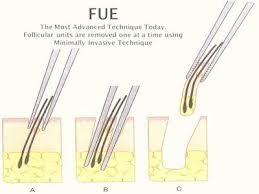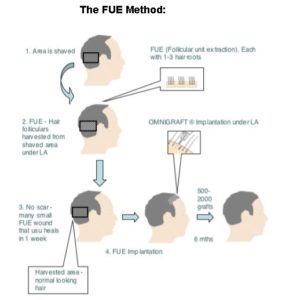FUE Hair Transplant Overview
Hair transplant is one of the effective hair restoration methods used by men and women who are suffering from genetic hair loss and other female or male pattern baldness. This hair restoration surgery takes about a full day and is usually done under sedation, or general anesthesia. In the procedure, healthy hair follicular units are extracted from the sides and/or back of the head (“the donor site”) and permanently transplanted into balding or hair loss and thinning areas (“the recipient site”).
The most common hair follicle extraction technique is follicular unit transfer (FUT) or commonly referred to as “strip harvesting”. This technique involves removing a single strip of the patient’s scalp where follicular units are plentiful and then cutting out the follicles to create grafts for transplanting.
In these days, another extraction technique is increasingly common, known as the follicular unit extraction (FUE), which involves removing each follicular unit at a time. This technique is more time consuming, but it avoids the linear scar from the donor site. This FUE method is usually chosen by men, particularly those under 30 who may wish to shave their head.


The average number of individual grafts needed depends on the patient; anywhere from 1,000 to 3,000 grafts is possible in an average day of surgery. It is relatively uncommon to have complications with the hair transplant surgery. Recovery time will depend on the extent of the hair surgery. Most patients reported mild pain, numbness and soreness after the surgery. However the pain can be controlled with medication prescribed by your hair transplant surgeon. It is also quite common for hairs from the transplanted follicles to fall out during the first month. The regrow will happen after 4 to 5 months in their new location.
The possible side effects may include scarring or uneven hair growth. If a patient’s follicle grafts didn’t establish well in the new site, the hair transplant surgeon may perform a follow-up surgery to transplant more follicles to fill in thinner areas and/or correct the scarring.
Hair transplantation can certainly restore the hair loss and boost one’s self image. However it is important to also set realistic expectations about the results of hair transplant. The hair transplant surgeon should take the time to discuss the patients’ feelings and answer their questions, including giving an estimate of hair transplant cost in Singapore. The hair doctor should conduct diagnostic examinations and tests to establish the likely cause for the hair loss. Thereafter he or she should discuss possible hair restoration treatment options. The best FUE hair transplant surgeon should be able to take great care to design a hair replacement surgery and treatment that will provide optimal result for the patient.
Related reference reading:
